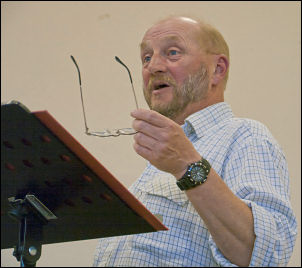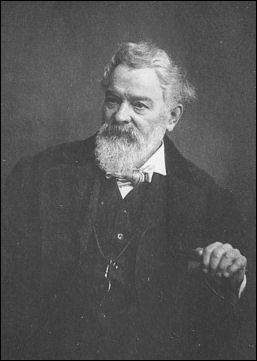|
Tue 14 Jun
2011
The Lancashire Cotton Famine by
Sid Calderbank |
|
Sid is a
writer, speaker and singer in Lancashire dialect and came to
tell us the story of the cotton famine on Lancashire cotton
workers.
He started by
saying the earliest recorded commercial cargo of cotton came
from Barbados and was landed at Lancaster in 1701. At that time
cotton manufacture was a cottage industry but over the next 50
years a series of technological innovations and improvements led
to an increase in cotton production. Later in the 18th century
Liverpool surpassed Lancaster as a port and the tonnage rapidly
increased.
The first
cotton mill was built on New Hall Lane, Preston in 1770. People
began pouring into the towns across Lancashire from rural areas
to work in these mills. Sid’s first song, ‘Handloom v Powerloom’,
described the choice people had to make, whether to continue
working for themselves or go to work in the factory. |

Sid Calderbank |
|
By 1860 though
there were 2,000 mills in Lancashire that employed 500,000
people and accounted for over 50% of England’s exports helping
to make cotton workers the highest paid industrial workers.
However, it was on 14 April 1861 that the first shots were fired
in the American Civil War, which lasted 4 years and cost 800,000
lives.
Cotton production ceased in the southern states, which caused
supplies to dry up in Lancashire and threaten cotton workers’
livelihoods. Savings were used up then clothes were pawned and
food used up, which caused harsh conditions. Sid read from a
passage by contemporary Rochdale author, Edwin Waugh, ‘Among the
Cotton Operatives’, that described the workers’ plight and their
reliance on parochial relief. A sad song, ‘Nobody Knows the
Trouble I’ve Seen’, followed this.
Extracts were read from a diary kept by a Richard Ryley, a
cotton worker and fiddle player from Barnoldswick that detailed
his busking on foot around West Yorkshire.
By November 1862 the number of out of work cotton workers
reached 250,000 and was a wretched situation for the workers.
Liverpool, though, did very well as tobacco and sugar was
unaffected and the little cotton that got through fetched 3 to 4
times its pre war price. The ship owners profited from breaking
the Union blockade of the Southern ports. A Liverpool ship, the
‘Alabama’, was fitted out with guns for such a job and Sid sang
a rousing sea shanty named after it.
At home John Whittaker as ‘A Lancashire Lad’, wrote to The Times
in April 1862 and Sid read out the moving letter. It caused
enough of a reaction for him to write again 3 days later. This
led to The Times running an editorial on the cotton workers’
wretched conditions. |
|
 |
An 1862
newspaper illustration showing people waiting in line
for food and coal tickets at a district Provident
Society office |
|
|
A poem,
‘Smokeless Chimney’s, was Sid’s next piece. It was written by,
‘Lancashire Lass’, who resided at Quernmore Hall, and was sold
for 1 shilling a copy to raise money for the workers. It raised
£160, which equated to 3,200 copies sold.
Funds were then set up to raise money for the workers, which
included one set up by the Lord Mayor of London – the Mansion
Fund set up for the Lancashire & Cheshire Operatives – to raise
funds totalling £528,000 across Britain and the empire.
Lord Derby helped raise £130,000 in one night at a function for
wealthy families. There many more acts of charity by mill owners
across Lancashire to ensure their workers were provided for
through the war years.
Sid finished
off the night with the conclusion of the sea shanty, ‘Alabama’.
The blockade-runner met its demise off Cherbourg at the hands of
the Union ship the Kearsage. Cotton workers supported this
action for though they were suffering they knew why the war was
being fought and did not support intervention on the South’s
side.
|

Edwin Waugh (1817 - 1890)
The Rochdale Poet and Author |
|
Sid concluded a
different but no less entertaining and informative evening with
the apt saying, ‘England’s bread was hung by Lancashire’s
thread’.
Peter Robinson |
|